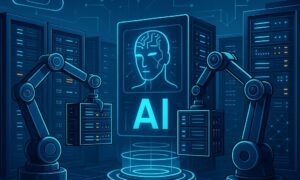The U.S. Centers for Disease Control & Prevention (CDC) identifies five broad and interconnected categories that impact overall health: genetics, behavior, environmental and physical influences, actual medical care, and social elements. These “determinants of health” are, in turn, affected by physical, emotional, social, and economic differences. According to the United States Agency for International Development (USAID), gender-related inequities contribute to excess women’s mortality. Studies show that compared to males, women with similar health conditions don’t always receive the same evidence-based care.
Working to transform women’s healthcare with AI expertise
According to Shailaja Salagrama, a digital engineer, research scholar, and champion of women’s health, “Whether they are conscious of it or not, almost everyone has some sort of gender bias. This bias can have negative consequences for female patients and professionals alike.” But Salagrama says using technologies such as artificial intelligence (AI) can help mitigate gender bias in healthcare. “It is one area where artificial intelligence may help to level the playing field by collecting or ‘scraping’ and then organizing the trove of information from all available digital files related to women’s health,” says Salagrama.

Shailaja Salagrama
Becoming a beacon of change
The consequences of gender inequity are starkly evident in medical research and healthcare. There is less research and fewer treatment options for conditions commonly experienced by women. Research shows that women are diagnosed later than men for more than 700 diseases. “Bias frequently manifests in the labeling of women as patients who either exaggerate their symptoms or suffer emotional anguish as a contributing factor to their illnesses,” emphasizes Salagrama. Furthermore, she notes that studies have demonstrated that women experience more prejudice about their weight than men, with women of color reporting more bias about their weight and even more significant gender disparity.
The pandemic exodus and gender bias
The pandemic’s impact was felt by the large number of women who left the medical workforce for various reasons, creating a void that negatively impacted the care of female patients. Gender harassment, salary inequity, and gender bias further contribute to this departure. Data from the Commonwealth Fund reveals that women physicians earn less than their male counterparts, even though they spend more time with patients and may have better listening skills. According to the study, female physicians earn only 74 cents for every dollar earned by their male counterparts.
A recent survey by Duke Health found that more than 50 percent of women believe gender discrimination among patients is a “serious problem.” One in five female patients felt their providers ignored or dismissed their symptoms. This raises an essential question: do female physicians better empathize with and understand issues related to women’s health?
AI is the catalyst for change
Historically, women have been underrepresented in health studies and research, “which can lead to a biased and incomplete understanding of women’s health issues,” noted Salagrama. “With AI-related tools like ChatGPT and other emerging technologies, it is possible to gather more data on women’s health issues and bridge this gap.” Here are Salagrama’s suggestions on how to use AI tools to collect more data on women’s health:
- Online forums and communities. AI can monitor online platforms where women discuss health issues, providing valuable information and personal experiences.
- Social media analysis. AI tools can analyze public posts and discussions on women’s health on social media platforms, identifying trends and concerns.
- Natural language processing. AI can analyze vast amounts of text data, including medical literature and research papers, focusing on specific keywords related to women’s health.
- Mobile health applications. AI can anonymize and aggregate data from health apps used by women to track various health-related information, providing researchers with valuable insights.
- Collaborative platforms. AI tools can facilitate collaboration between researchers, healthcare professionals, and women to encourage data sharing and participation.
Salagrama, an accomplished developer with a focus on data security and user privacy for mobile and web applications, prefers to adopt an optimistic view that change is possible by leveraging AI-related tools like deep learning and large language models (the algorithmic basis for chatbots such as ChatGPT and Bard) and adopting inclusive research practices. Salagrama says, “We can work toward a more comprehensive understanding of women’s health issues and promote better healthcare outcomes for all.”
Strategies against gender inequity
USAID has updated its Gender Equality and Women’s Empowerment Policy to address disparities across all sectors. While only 28 percent of the current science, technology, engineering, and math (STEM) workforce is comprised of women, higher-paying positions in health informatics and health information management are increasingly classified as STEM. Salagrama is encouraged by these changes. “There seems to be more investment in the recruitment of women into healthcare and similar fields and more attention to why this might improve the overall healthcare of women while reducing gender inequalities,” she says.
Reducing gender healthcare inequalities will undoubtedly involve digital technologies, but Salagrama emphasizes that ethical considerations and privacy protection should always be prioritized. Safeguarding personal information and ensuring informed consent are essential in any data collection. Salagrama anticipates that there will be a greater demand for professionals as AI and other technologies become more widely used. “As healthcare organizations better understand how AI, machine learning, and other emerging technologies can increase operational efficiency, reduce costs, and improve patient care, there will be an increased demand for highly skilled workers,” Salagrama says.
Salagrama’s groundbreaking work at the intersection of AI and women’s healthcare can pave the way for a more equitable future in the medical profession. Her dedication and expertise and the efforts of others working toward that same goal offer hope to women everywhere who deserve equal and evidence-based healthcare. AI-enabled machines can potentially solve labor shortages, yet concerns about job displacement and workforce skills remain. Blending the benefits of AI with worker needs and industry requirements is vital. Implementing AI effectively requires considering an upfront investment, its impact on current employees, training, and ethical job displacement concerns. “In short,” concludes Salagrama, “AI should amplify human capabilities, not replace them entirely.”
Written by: Gene Marrano, Submitted by: Trade Press Services.
About the Author:
Gene Marrano is an award-winning radio, print and broadcast journalist and freelance writer who writes on various topics, including the technology industry. For further information, contact gmarrano1257@gmail.com.


































